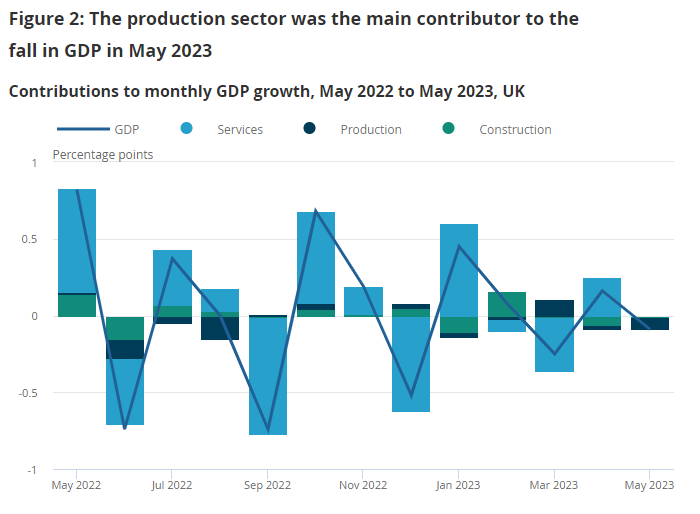UK Economy Outperforms Forecasts as Growth Nears Standstill
- Written by: James Skinner
-

Image © Adobe Stock
The UK economy outperformed expectations for the month of May when an additional public holiday connected with the King's Coronation had less of a negative impact than many envisaged though was still enough to leave output little changed for the second quarter at the midway milestone.
Economic growth turned negative again in May when falling construction and manufacturing sector production output led to a small -0.1% contraction almost entirely reversing the 0.2% increase in GDP seen in April, which means the economy had grown 0.1% for the second quarter at the midway point.
Human health and social work activities supported output from the services sector and kept the economy from contracting further in May though GDP growth was zero for the three-month period running into the end of May when construction and manufacturing production industries were the main breadwinners.
"This was not surprising as the month included the Coronation, which led to one less working day, and industrial action in some sectors of the economy," says Barret Kupelian, chief economist at PWC.
“Looking ahead, our focus will be on the monthly inflation figure and in particular services and core inflation which is likely to determine the short-term path of the Bank of England’s policy rate,” he adds.
Source: Office for National Statistics.
Separately, the Office for National Statistics said the trade in goods and services deficit had deepened from -£14.6BN in April to -£18.7BN in May, a much larger deterioration than was anticipated by the consensus among economists and one that likely added to the decline in economic output.
Trade deficits are treated as a subtraction in the calculation of economic output while surpluses are an addition: The UK's trade in goods deficit widened by £3.5 BN in May to reach £19.8 BN for the month while its trade in services surplus narrowed £0.3 BN to reach £36.5 BN.
Thursday's data followed Tuesday's release of employment figures suggesting an improvement in labour market conditions during the month of May when the number of registered welfare claimants fell by 22.5k while an improvement in labour market participation lifted the unemployment rate from 3.8% to 4%.
"Looking ahead, mortgage refinancing will deliver only a 0.2pp hit to real disposable incomes every quarter, so it is unlikely to be a decisive drag," says Samuel Tombs, chief UK economist at Pantheon Macroeconomics.
"That said, many households will seek to rebuild the savings buffer that they have depleted over the last 18 months, while others will increase their debt repayments in response to the jump in interest rates. Growth in households’ real expenditure, therefore, will lag behind their incomes," he adds.
Source: Pantheon Macroeconomics.

